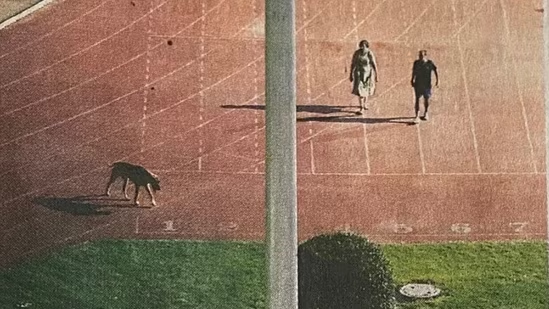The Indian athlete and sport itself is at the back of the priority queue
After news of the Thyagraj Stadium being emptied of athletes, only to have Delhi’s Principal Secretary (Revenue) Sanjeev Khirwar and his Great Dane perambulate around the venue appeared, the response came swiftly.  PREMIUM
PREMIUM
The Delhi government said all stadia would be open for athletes till 10pm. The Home Ministry transferred Khirwar to Ladakh and his wife Rinku Dugga to Arunachal Pradesh. The couple are from the IAS’ AGMUT (Arunachal Pradesh-Goa-Mizoram-Union Territories) cadre. Rather than being made an example, the rapid transfers take the individual involved out of sight, out of media mind. If I were a citizen of Arunachal or Ladakh, I would be deeply insulted.
I sent messages across Indian sport looking for similar acts of entitlement and the replies featured not only babus, but every stripe of big wig: federation officials, politicians, particularly those who fit both criteria. A decade ago, this particular administrative trifecta - babus, netas, federation officials – piled onto mega-games contingents. They occupied Games Village spots often in as large a number as athletes and staff. The situation is vastly improved but Paralympic sport now comprise the new gravy train. India’s 2022 Winter Olympics contingent was four-strong: one competitor, three non-competitors.
Journalist Abhijeet Kulkarni remembers a national TT tournament in Manesar when a match between Achanta Sharath Kamal and Soumyadeep Roy, top players both, was stopped after three games. Because a cultural show had to be held for the chief guest who was late.
In 2017, the New Indian Express reported that athletics coach and his trainees being turfed out of Bangalore’s Kanteerava Stadium. One of athletes had asked a walker to keep off their training path, the walker was an IPS officer’s wife. The coach was asked to leave Kanteerava because he was supposedly not qualified to coach - some of his athletes were training for CWG qualification. The 2017 Nagpur nationals final between PV Sindhu and Saina Nehwal was delayed because the event’s closing ceremony, plus speeches, were held before the event came to an actual close.
The interruption of Indian athletes in preparation, warm-up or competition is routine in Olympic sport. Because our athletes are not located front and centre in our sport’s landscape. They are placed mostly on the side, slightly behind or worst case, at the feet of those who control their sport. In his memoirs, Abhinav Bindra remembers Suresh Kalmadi refer to him as Avinash, just after he won Olympic gold. (India’s first individual gold before Neerav Chabria won the second in Tokyo.)
Over the last decade, there has been tremendous progress around the needs of elite Indian athletes. So much so, we know that medallists/superstars use their status to extract maximum from the government resource-pie. Reverse-entitlement, if you like. Like the well-connected young shooter who would reach the airport with his weapon and call federation officials to sort out his paperwork/licences asap.
But the case of the perambulating dog, however reminds us that outside of the elite bubble, outside the ground, the Indian athlete and sport itself – playing, training, competing – is at the back of the priority queue. Stadiums owned by local governments are used as venues for weddings, election rallies, rock concerts, their grounds for parking lots. The buildings are often better protected than the sporting interests for which they were built, like we saw at Thyagraj. Its access becomes an instrument of power. Like with the Ambedkar Stadium, whose iconic status as the home of Delhi football, stays deliberately eroded. Football Delhi uses the Nehru Stadium more than Ambedkar, because the MCD’s Rs7500 per day cost doesn’t make financial sense in their annual 2000-odd game calendar.
Bangalore, where I live, has a centrally-located but very badly-maintained football ground. From 2014-15, JSW’s Bengaluru Football Club (BFC) chose to play its matches at the Kanteerva. It has put them at loggerheads with the Karnataka Athletics Association. The stature of the 50-year-old Bangalore Football Stadium has been sent into stagnation. Rather than be a thriving headquarters for Bangalore and Karnataka football, its matches and events are held fitfully. The last piece of major news from the ground involved a gang war murder in the referee’s room before an A-division women’s league match in September 2021.
It doesn’t matter whether Khirwar was directly responsible for the athletes being cleared out of Thyagraj earlier than usual or not. Near the stadium, is Thyagraj Park with acres of space, its closing time on Friday showing as 10pm. But Khirwar chose the Stadium because he could, he possessed the power of access after the athletes were shut out. That long lens photo in the Indian Express became stinging symbol: no matter our achievements on the world stage, regardless of Khelo India, when the demands of even minor masters have to be served, it is very easy to sideline sport in our country.
Experience unrestricted digital access with HT Premium
Explore amazing offers on HT + Economist Start 14 Days Free Trial Already Subscribed? Sign In
Disclaimer: The copyright of this article belongs to the original author. Reposting this article is solely for the purpose of information dissemination and does not constitute any investment advice. If there is any infringement, please contact us immediately. We will make corrections or deletions as necessary. Thank you.







